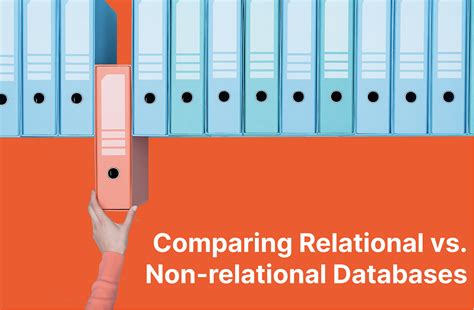

The Ultimate Guide to Relational vs. Non-Relational
Introduction
In the era of big data and rapid technological advancements, choosing the right database type for your application has become a pivotal decision. This article provides a comprehensive guide to the two primary database categories: relational databases and non-relational databases. We’ll delve into their unique characteristics, advantages, disadvantages, and applications to help you make an informed choice.

Relational Databases
Definition
Relational databases are based on the relational data model, where data is organized into tables with columns and rows. They impose a structured schema that defines the relationships between these tables.
Advantages
- Data integrity: Relational databases maintain referential integrity, ensuring consistency and accuracy in data relationships.
- Data standardization: The structured schema standardizes data formats, facilitating data management and analysis.
- Data normalization: Normalization techniques help optimize data storage and minimize data redundancy.
- Queries and analytics: SQL, a powerful query language, enables efficient data retrieval and complex data analysis.
Disadvantages
- Complexity: Relational databases can be complex to design and manage, especially for large and complex datasets.
- Scalability: Scaling relational databases can be challenging and expensive, particularly for applications that require horizontal scaling.
- Performance bottlenecks: Queries can become slow when dealing with vast datasets, especially for complex JOIN operations.
Use Cases
Relational databases are ideal for applications requiring:
- Strong data integrity and consistency
- Structured data with predefined relationships
- Compliance with data regulations and standards
- Complex data analysis and reporting
Non-Relational Databases (NoSQL)
Definition
Non-relational databases, commonly known as NoSQL, are a collection of different database technologies that deviate from the relational model. They offer flexibility and scalability for various data types and application requirements.
Types of NoSQL Databases
- Key-value stores: Store data as simple key-value pairs, offering fast lookups and scalability.
- Document databases: Store data in flexible JSON or XML documents, enabling complex data structures and schema evolution.
- Wide-column stores: Store data in tables with a large number of columns and flexible schemas, suitable for large datasets.
- Graph databases: Represent data as nodes and edges, capturing complex relationships and enabling efficient graph analysis.
Advantages
- Flexibility: NoSQL databases provide flexibility in data schemas and data types, accommodating diverse data structures.
- Scalability: They offer horizontal scalability, enabling cost-effective expansion of database capacity.
- Performance: Optimized for high-volume data and fast data access, NoSQL databases excel in real-time applications.
- Simplicity: NoSQL databases often have simpler design and management processes compared to relational databases.
Disadvantages
- Data integrity: NoSQL databases may not enforce strong data integrity rules, potentially compromising data consistency.
- Data standardization: Lack of standardized data structures can make data integration and analysis more challenging.
- Query capabilities: Querying NoSQL databases can be more complex than SQL, especially for complex data relationships.
Use Cases
NoSQL databases are well-suited for applications requiring:
- High scalability and performance
- Unstructured or semi-structured data
- Flexibility in data schema and storage
- Real-time data processing
Which Database Type to Choose?
The choice between relational and non-relational databases depends on the specific application requirements. Consider the following factors:
- Data structure: Relational databases excel in structured data with well-defined relationships, while NoSQL databases are more suitable for unstructured or semi-structured data.
- Data volume and scalability: For large datasets and demanding scalability, NoSQL databases offer better performance and cost-effectiveness.
- Data integrity and consistency: If data integrity is crucial, relational databases provide stronger guarantees.
- Query complexity: Relational databases are more suitable for complex data analysis and reporting, while NoSQL databases are optimized for simpler queries.
- Performance and latency: NoSQL databases typically offer faster access and lower latency, making them a good choice for demanding real-time applications.
Market Size and Trends
According to Gartner, the global database market is projected to reach $100 billion by 2025. The non-relational database market is expected to grow at a faster pace than the relational database market, driven by the proliferation of unstructured data and cloud computing.
Emerging Technologies
- Hybrid databases: Combining the strengths of relational and non-relational databases, hybrid databases offer flexibility and scalability for diverse data requirements.
- NewSQL databases: NewSQL databases aim to provide the scalability and performance of NoSQL while maintaining the data integrity and consistency of relational databases.
- Graph databases: Graph databases are gaining popularity for applications that involve complex relationships and graph analysis.
- Quantum databases: Quantum computers hold promise for significantly accelerating database operations, particularly for complex queries and data mining.
Real-World Applications
- Social networking: NoSQL databases are widely used for storing and managing vast amounts of unstructured data generated by social media platforms.
- E-commerce: Relational databases are commonly used for managing product catalogs, orders, and customer information, ensuring data integrity and compliance.
- Financial services: NoSQL databases are used for fraud detection, risk management, and real-time analytics, providing fast and scalable data access.
- Healthcare: Hybrid databases combine the strengths of both database types, enabling efficient storage and analysis of medical records, patient data, and biomedical research data.
Pain Points and Motivations
Pain Points
- Legacy relational databases: Organizations struggle to scale and modernize legacy relational databases, which can impede business agility.
- Data sprawl: The rapid growth and diversity of data sources create challenges for data management and integration.
- Real-time data processing: Traditional databases often struggle to keep pace with the demand for real-time data processing and analytics.
Motivations
- Digital transformation: Organizations are motivated to adopt modern database technologies to support their digital transformation initiatives.
- Data-driven decision-making: The need for data-driven decision-making drives the demand for databases that can handle large volumes of data and provide efficient analytics capabilities.
- Cloud migration: The transition to cloud computing platforms has increased the need for scalable and flexible database solutions.
FAQs
-
What is the difference between a relational and a non-relational database?
– Relational databases organize data in tables with well-defined relationships, while non-relational databases offer flexibility in data structures and storage. -
Which database type is better for big data?
– NoSQL databases are typically better suited for big data applications due to their scalability and performance advantages. -
Can I use both relational and non-relational databases in the same application?
– Yes, hybrid databases combine the strengths of both types, providing flexibility and scalability. -
What are the emerging trends in database technology?
– Hybrid databases, NewSQL databases, graph databases, and quantum databases are gaining popularity, offering innovative solutions for complex data management challenges. -
How can I choose the right database type for my application?
– Consider the data structure, volume, integrity requirements, query complexity, and performance needs to make an informed decision. -
What is the future of database technology?
– The database landscape is expected to evolve with continued innovation in areas such as data virtualization, data fabrics, and intelligent databases.
Reviews
- “Relational databases provide the foundation for many critical business applications, ensuring data integrity and compliance.” – Gartner
- “NoSQL databases are revolutionizing the way we manage and analyze data, enabling real-time insights and scalability for demanding applications.” – Forrester
- “Hybrid databases offer the best of both worlds, combining the strengths of relational and non-relational databases to meet diverse data management needs.” – IDC
- “Graph databases are unlocking the power of complex data relationships, providing new insights and analytical capabilities for various domains.” – McKinsey & Company
Conclusion
The choice between relational and non-relational databases depends on the specific requirements of the application. Relational databases remain essential for structured data and data integrity, while NoSQL databases offer scalability, flexibility, and performance for unstructured data and demanding real-time scenarios. Emerging database technologies, such as hybrid databases and NewSQL databases, provide innovative solutions for complex data management challenges. By understanding the unique characteristics and use cases of both database types, organizations can make informed decisions to optimize their data management strategies and drive business success.
Call to Action
Take the following steps to improve your database strategy:
- Evaluate your existing data and applications to identify opportunities for modernization.
- Explore emerging database technologies to address your pain points and meet your future data management needs.
- Partner with experienced database experts to guide your implementation and optimization efforts.
- Stay informed about the latest industry trends and best practices in database management.










